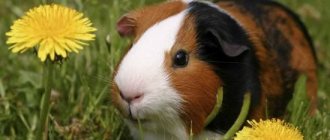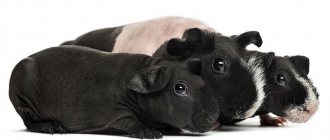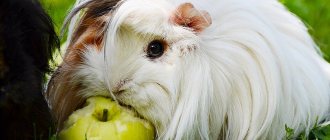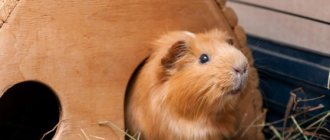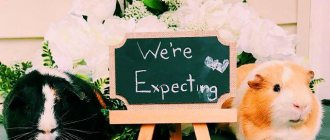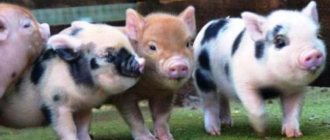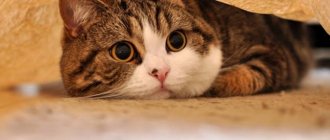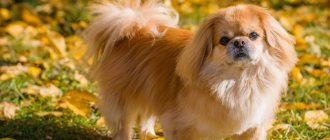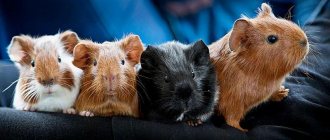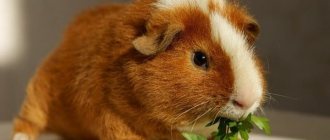/ Guinea pigs / Characteristics of a guinea pig rosette
0
3336
Article rating
The wire-haired rosette guinea pig is one of the popular pets to keep at home, despite its rather nasty and pugnacious temperament. In addition to its unusual appearance, the rosette guinea pig also has a number of problems with breeding.
Guinea pig rosette
Description and distinctive features
The Abyssinian guinea pig differs from other breeds in its unusual coat.
The hairs grow in such a way that they form a large number of rosettes - from 8 to 12 pieces. In purebred individuals, the rosettes are regular in shape and located symmetrically: two each on the back of the nose, forearms, hind legs, and sacrum; and four go along the back. The color palette is varied - from ordinary plain ones to rare multi-colored ones. Breed standard:
- the presence of a “collar” and sideburns;
- short and dense coat (with hairs 3-3.5 cm in length);
- wide head and flattened muzzle.
Not all animals with rosettes are necessarily Abyssinian. Confirmation of purebredness occurs at the 20th week of the animals’ life. Before this, the rosettes are not so pronounced. If there are more than 30 rosettes, the individual is no longer considered a purebred. Animals with smooth fur and weakly curled combs are also not considered purebred.
Despite the name, pigs do not originate from Abyssinia (modern-day Ethiopia). It is known for sure that the breed originates from South America. In Europe, they met representatives of the Abyssinian breed back in the Victorian era. It is now impossible to establish the origin of the name, since no data has been preserved about it.
Did you know? The long jump record belongs to an Abyssinian guinea pig named Truffle (Great Britain). At the competition in April 2012, Truffle showed a result of 48 cm.
Unique features of the breed are the rosettes in which the Abyssinian's long fur is wrapped. What is also unique is that the number of sockets must be even – from 12 to 30 pieces, and they are located symmetrically.
The exterior of these pets looks like this:
- the body is compact, with correct proportions;
- head triangular elongated shape;
- narrow shoulders, so there is no border between the head and body;
- the wool is dense, hard;
- the dorsal ridge of fur is clearly defined and follows along the entire spine;
- The color can be white or any shade from golden to chocolate.
In this case, special attention is paid to the quality of the rosettes - they should be clear, well drawn, with a defined wool comb along the edge. The height of an adult Abyssinian reaches 28 cm. The weight of a male is 0.8–1.1 kg, of a female – 0.7–0.9 kg. These are not very large pigs.
Abyssinians are extremely inquisitive and actively interested in everything new around them. This is one of the most restless breeds. The life expectancy of Abyssinians is 8–10 years. The breed has good immunity and is rarely exposed to disease.
Breeding and reproduction
Rosette guinea pigs are difficult to breed. Females are allowed to mate at the age of at least 5 months. The choice of future parents is taken very seriously. Not only the pedigree is assessed, but also the data of the animal itself. But even the best selection can result in smooth-haired offspring. Crossing with other types of pigs will also not give the desired breed. The offspring will lose the natural trait.
Rosette guinea pigs often give birth to smooth-haired babies.
Crossing Abyssinian guinea pigs with long-haired breeds is unacceptable. The offspring appears with a completely indistinct type of coat.
Compliance with the breed is assessed in animals at the age of 20 weeks. In younger pigs, the rosettes are not clearly expressed and may lie close to the body. Individuals are rejected if the number of rosettes is less than 8 and more than 12, as well as if the wool is smooth and the combs are weakly curled. If there are many cubs in the litter with such defects, you will have to change the male, and in some cases the female.
Origin story
Rosette pigs appeared in Europe in the second half of the 19th century. Initially, representatives of this breed lived in England; later the animals spread throughout Europe, where they caused considerable excitement. It is believed that the ancestors of these animals lived in Central and South America. As for the name, the exotic prefix “Abyssinian” is very well chosen for these bizarre animals.
Pigs have nothing to do with cats of the same name. But why they were called that is still an unknown fact. At the same time, many are interested in how long these animals live at home today.
If history is to be believed, these rodents first appeared in Brazil as a result of a natural mutation. Currently, it is quite difficult to find this variety of guinea pigs, since it is very difficult to obtain this variety during the breeding process and requires painstaking selection work. Now only professionals and amateurs of this particular breed are breeding them.
Professionals breed rosette guinea pigs
After all, it must fully meet all requirements and standards. Even the slightest deviation from the established standards leads to the rejection of animals.
Coloring
The most common are speckled pigs; their coat consists of an alternation of black and red hair, while solid spots are not allowed. If light hairs dominate, then the rodents are classified as light variegated, and if there are significantly more black hairs, they are classified as dark variegated.
There are also tortoiseshell pets whose rosettes are of different colors and each of them should not have other color impurities. The order of the sockets does not matter.
The third color is roan, when the main color is diluted with white hairs, the so-called grey. The following types of roanity are distinguished:
- blue - a mix of black and white,
- strawberry - a mixture of white and red (red),
- variegated when the body contains black, red and white shades.
The fourth option is selfie or plain. The most popular and frequently encountered are black and red selfies.
Origin story
The Abyssinian has been known to people since the 16th century, when it was first brought to Europe from South America, the homeland of guinea pigs. The origin of the name is not precisely established. Contrary to their similar sound, these animals are in no way connected with the ancient country of Abyssinia, which was located on the African continent (in the territory of modern Ethiopia).
The breed was not bred artificially, it appeared as a result of a natural mutation. Abyssinians are considered one of the oldest representatives of the guinea pig species. Currently, only experienced breeders and specialized centers are engaged in breeding the breed in Europe. This is due to the difficulties that accompany the selection process.
Health and life expectancy
Guinea pigs live on average 6-8 years. In rare cases, a rodent can live a year or two more. This depends on natural immunity and conditions of detention. Representatives of this breed, if well cared for, get sick quite rarely.
- Health can suffer due to parasites - fleas, ticks, helminths.
- Sometimes rosette pigs suffer from digestive problems. Gastrointestinal diseases are most often caused by dietary errors.
- Rodents also suffer from conjunctivitis and other eye diseases.
Description of the breed
According to the standard, all rosettes of Abyssinian wool grow from one point. The eight main sockets are arranged as follows:
- on each side of the body the rosettes are on the same line and at the same distance from the collar and sacrum,
- on the shoulders strictly above the paws,
- rosettes on the hips form a circle,
- The rosettes located on the sacrum should not intersect.
Abyssinians may have additional rosettes on the tummy and nose, and one on the shoulders.
However, additional rosettes should not disturb the basic coat pattern. Rosettes on the nose are an indicator of the high-breeding of the animal.
The Abyssinian guinea pig has a very thick coat. Smooth fur is allowed only on the tummy. Abyssinians with agouti and black coats have coarser hair. Pigs have a medium length body, deep shoulders and croup. Paws are straight. The muzzle is neat, with pronounced sideburns made of long hair, a mane between the ears, and a kind of collar around the shoulders.
Rosette guinea pigs most likely carry genetic cells from Brazilian rodents in their pedigree and appeared due to natural gene mutation. Europe met them at the end of the 19th century, where they arrived from the South American continent.
Rosette guinea pigs owe their spread to English breeders who were actively breeding them and the resulting breed began to be called Abyssinian. Another name for them is Japanese.
To breed rodents with ideal rosette appearance, crossing only with their wire-haired relatives is required, and mixing with animals with long hair negatively affects the quality of the breed.
The main feature of Abyssinian guinea pigs lies in their character. They are distinguished by their friendliness and good nature. They do not tend to bite their owners, and it takes a little time to tame.
Black Abyssinian guinea pig
Among the main advantages of pets are:
- possibility of keeping for asthmatics and allergy sufferers;
- ability to get along with children;
- high development of mental abilities;
- strong immune protection.
READ Pancreatitis in cats - 125 photos and videos of the main symptoms and treatment methods
Another amazing property is keen hearing. The animal can hear the owner outside the apartment when he goes up the stairs. In this case, the pig begins to squeak joyfully.
Agouti Abyssinian guinea pig
Additional characteristics of character and temperament:
- love to sit in the owner's arms and cackle with pleasure;
- with a special credit of trust, licking a person’s fingers;
- fear of sudden sounds and movements: a sudden change in the situation may cause a panic attack;
- According to some owners, their favorite delicacy is fresh cucumbers.
Good health is considered one of the advantages of Abyssinians. Visits to the veterinarian can be reduced to a minimum if:
- follow the rules of care;
- Responsibly select food;
- Give your pet enough affection and time.
If these conditions are met, the pet lives from 8 to 10 years.
It is easy to determine that a pet is unhealthy: rosette pigs are characterized by activity and restlessness, and a constant interest in new things. If the animal stops eating and does not leave the house, it means that the disease has nevertheless overtaken the animal and you should immediately contact a veterinary clinic.
Rosette guinea pig color cream
Under natural conditions, animals live in groups of 5-10 individuals. They tend to build burrows together and coexist within the same territory. However, when kept at home, rodents exhibit a behavioral trait such as pugnacity. Accordingly, it is strictly forbidden to house two males in one cage.
When trying to place two opposite-sex but adult rodents together, they need to be given time to get used to each other. The process takes up to a month and is not always successful. Individuals from the same litter that grew up together will get along really well with each other.
Show Abyssinian pigs should ideally have ten rosettes: four on the back, two on the hips and two more on the shoulder blades. Representatives who have a rosette on their nose are especially valued. The length of an adult is on average 25-30 cm. The female’s fur is softer and more pleasant to the touch. In general, rosette pigs are considered wirehaired.
Sorry, there are no surveys available at this time.
According to the standard, the rosette pig can be either plain or spotted. Sometimes there is a tortoiseshell color, in which red and black are mixed, as well as blue, which implies a mixture of white and black. The most common are piebald pigs. The length of the fur cannot be more than four centimeters.
These pets are perfect for lazy owners as they do not require much care. If you decide to house several animals of this breed, it would be better to create a family of them. In this case, the ideal option would be to settle one male and several females. In this case, the boy plays the role of a peacemaker.
The cage of a rosette pig should be spacious. It is better to sprinkle sawdust on the surface, among which you must place a feeder and a drinking bowl. The cage should also provide a safe haven for your pet, where he can feel safe.
Feeding
Representatives of the Abyssinian breed have a good appetite, which extends to many foods. You can feed your animals healthy ingredients from the table or purchase special food mixtures at pet stores. The main food in summer is grass, and in winter - hay.
Care
From time to time it is necessary to comb the fur, trim the claws and, of course, monitor the general condition of the pet, preventing the development of diseases. How long do these pets live? If properly maintained, such a pig can live from 8 to 12 years.
Games
Abyssinian rosette pigs are distinguished by their cheerful disposition and amusing character. They are able to get along with others and are often good friends with young children. This pet can even be taught to sit on its hind legs if you set such a goal. To play in a cage with a pet, you need to install a wheel, a ladder, balls and various rattles, which can be purchased at any pet store.
However, additional rosettes should not disturb the basic coat pattern. Rosettes on the nose are an indicator of the high-breeding of the animal.
Rosette guinea pigs differ from all other breeds in that they have intricate fur patterns that look very much like rosettes.
Guinea pig fur patterns resemble rosettes
Sockets should be located as follows:
- There should be two rosettes on the back of the nose;
- there are also two rosettes in the forearm area;
- there are two rosettes on the hind legs;
- there are two rosettes on the sacrum;
- four sockets on the back.
In addition, rosette guinea pigs have the following characteristic features:
- Pronounced mustache.
- Wide head.
- Presence of sideburns.
- Bright and bulging eyes.
- Widely spaced ears of medium size.
- Compact muscular body.
- Thick, coarse fur.
All rosette guinea pigs have a mustache. Thick, coarse hair is another characteristic feature of the animal. Rosette guinea pigs can be recognized by their bulging eyes
The nature of the rosettes is assessed and the breed is determined at the age of more than 20 weeks, since until this moment they are not clearly expressed and can fit tightly to the body. If an animal has more than 30 rosettes after 20 weeks of age, it is discarded. Also, all guinea pigs whose combs are loosely curled and whose hair is smooth are subject to culling.
Games
Pet character
Abyssinian pigs have a calm character. They rarely decide to bite people and almost never show aggressiveness. But this does not mean at all that the animal is not able to stand up for itself. Just the opposite: two females can begin to sort things out, and the males will even get involved in a fight.
If the animals are related by blood, then most likely they will live well with each other. By the way, this breed is classified as difficult to breed. The rosette pig almost always gets along with people and happily “communicates” with its beloved owner. As long as they live nearby, they make a person happy!
It is generally accepted that Abyssinians have a more playful character than their relatives. They are active and love to communicate, quickly becoming attached to their owners. With proper patience, they can be trained and trained.
The average lifespan of a pet is 5 years. Subject to the conditions of detention and good immunity, the period increases to 7-8 years.
Keeping an Abyssinian pig
The care and maintenance of Abyssinian pigs is not much different from the maintenance of other breeds. The animals have a peaceful character and easily get along with each other and with other pets. They quickly get used to their owner, do not show aggression and get along well with children. Abyssinians hardly fight, which makes it possible to keep an entire family in one large cage. Clarification of the relationship between the animals is possible only if a new adult appears. Females can also fight among themselves for the attention of the male, but this rarely happens.
Abyssinians are distinguished by good health - they are less likely to suffer from colds and various infections. Another advantage of Abyssinians is that they smell less, so it is enough to clean the cage once a week. The structural features of the coat allow you to comb the animal once every two or three days. Some owners brush their pets with a regular comb once a week. Regular procedures include trimming nails, cleaning ears, preventing intestinal parasites, and inspecting fur for lice and ticks. Abyssinians are prone to obesity, so when composing the animal’s diet, it is necessary to reduce or completely eliminate roughage combined feed and add juicy greens, fruits and vegetables.
Improper nutrition will not only lead to the problem of excess weight, but will also affect the quality of the coat, digestion, and the functioning of the heart muscle.
Properly caring for an animal means prolonging its happy and healthy life.
House Rules
- put a cage based on the number of rodents that will live, 0.5 m for each,
- install a drinking bowl with a feeder (2 pieces),
- pour filler,
- put the toys
- make mazes,
- purchase a brush or a special comb for wool for care.
READ Feeding broilers at home: what and how
When keeping an Abyssinian animal at home, comb it once a week, wiping the villi with a dry cloth, removing dead hair. Pets require a daily walk outside the cage, which provides them with proper activity, extending their lifespan, and they live for 7-8 years on average.
four on the back and four on the front parts of the body, with the front parts being two on each side, located one under the other. This symmetry determines the quality of the breed. It is also possible to have “rosettes” on the surface of the animal’s thighs, head and nose. The hair growth on the cheeks is directed forward, resembling sideburns.
Rosette guinea pigs have a strong build. They look like a mini-zucchini, the muzzle is not elongated, the ears are located perpendicular to the head, the eyes are large, resembling almond grains. When assessing a breed, pay attention to the length of the coat, its stiffness, the number and location of “rosettes”.
The presence of the “rosettes” themselves is explained by the result of changes (mutations) in the genes responsible for hair growth. Such “rosettes” can appear as a result of crossing an Abyssinian with another type of guinea pig, preserving the rosettes themselves, but changing their number and location.
Rosette guinea pigs are very active and curious in nature; a healthy rosette guinea pig is constantly on the move, friendly and intelligent. If you work with such a pet, taming occurs quickly, the animal will respond to its name.
When choosing guinea pigs, sometimes the question arises of what gender the individual is in front of you. And indeed, it is not always possible at first glance to distinguish a female pig from a male, since outwardly rosette guinea pigs almost do not differ in color or weight. In order to finally determine the sex of the animal, you need to carefully take the animal in your hands, turn it upside down and gently press on the lower abdomen, above the genitals. In females, a Y-shaped slit will be visible near the anus, and in males, when pressed, a reproductive organ will appear.
As a rule, guinea pigs take care of themselves, but, nevertheless, during molting, their fur requires more attention: the fur may roll into lumps, then you should either comb it (if the condition of the lump allows it), or carefully cut it, carefully holding the sharp edges of the scissors at a distance from the animal's skin. It is most convenient to do this in a free, clean and bright space to avoid injury to the pig due to its uncomfortable position.
It is also possible to bathe the animal, but only if, for example, the pig gets dirty with soil during a walk or the fur is dirty after using the toilet.
For bathing, you can use a shallow object filled with water up to 3-4 centimeters along the edge, lowering the animal into the water as much as necessary. While bathing, you should make sure that water does not get into your nose and ears. If you need to use shampoo, you can use one that is softer and hypoallergenic for this purpose, and also make sure that the soapy substance does not get into your pet’s eyes, nose and ears.
Make sure that the shampoo is thoroughly washed off the guinea pig's skin, as its residual elements can cause irritation of the mucous membranes and skin, and if the chemical gets into the animal's oral cavity, it can cause poisoning. After bathing, do not leave the animal wet, carefully swaddle it in a towel and let it dry, gently wipe the fur.
As for the diet of guinea pigs, you need to be very careful: these creatures are herbivores and prefer plant foods, such as cucumber, cabbage, apples, cereal grains, hay and seeds. Their chewing apparatus is designed to bite off (front incisors) and chew. The frequency of feeding depends on the age and condition of the guinea pig, it is necessary to ensure that the guinea pig’s diet is rich in vitamins and microelements, do not be lazy to change the water every day, since contaminated food and water in the gastrointestinal tract -intestinal tract may become infected.
There are many varieties of guinea pigs in the world, differing from each other in coat texture, color, and size. Abyssinian (rosette) guinea pigs got their name due to the special appearance of their coat - in the form of twisting spirals, which are called rosettes.
Your pet will need a cage. Suitable housing dimensions for one individual are 50x40x50 cm. Aquariums and terrariums are not suitable for living - there is no ventilation and they are difficult to clean. The following is placed in the cage:
- house;
- food bowl;
- drinking bowl;
- tray;
- mineral stones for grinding teeth.
Sawdust or wood filler is used as bedding - it is easy to change and it perfectly absorbs unpleasant odors. The litter is changed as it gets dirty, but at least 1-2 times a week.
Abyssinian guinea pigs are sensitive to room temperature. Suitable indicators for them are 18-23 degrees. The cage is placed in an appropriate room, away from doors and windows (sources of drafts), direct sunlight and heating devices. Pigs do not like constant noise, so you should not place their home near a TV or computer.
Animals are often kept in pairs so that they do not get bored alone without their owner. Preference is given to same-sex individuals to avoid problems with reproduction and placement of cubs. For two pets you will need a larger cage and cleaning will need to be done more often.
[Hide]
Abyssinians are considered unpretentious pets, however, a minimum set of care procedures must be required, otherwise the pet may fall ill, or its character will change for the worse.
Rosette tortoiseshell guinea pig
Arrangement of the cage
The cage for a rodent requires a small one, but it is important to pay attention to the length: the pig loves to walk, so the front and back walls should be at least 1 m. The housing should be equipped with the necessary equipment:
- a house in which the animal hides, rests or stores supplies;
- drinking bowl and feeder;
- manger for hay, can be attached both to the outside of the cage and to the inside;
- toys - a wheel and a ladder, on which young individuals happily climb;
- mineral stone for grinding incisors.
You need to add sawdust to the bottom, but it is better to use specialized granules. It is better to arrange the toilet in the corner opposite the “dining room”. It is recommended to carry out general cleaning of the cage every week, and feeders and drinkers must be washed daily.
READ How to remove ticks from a cat at home
Abyssinian guinea pig - piebald color
Diet
The diet is based on special industrial feed with the addition of grass in summer and hay in winter. You should also include fruits and vegetables in the menu, guided by your pet’s preferences and the list of allowed foods.
The body of guinea pigs does not produce ascorbic acid. It is necessary to provide them with a sufficient amount of substance with the help of rose hips, parsley, and sweet pepper.
Owners of Abyssinian pigs should be aware that their pets' fur requires regular and thorough grooming. Once a week, the skin should be wiped with a cloth soaked in plain water to remove dead lint and dirt. It is also necessary to comb the fur with a special device with a soft working part. Hard plastic and metal can damage your pet's skin.
Baby Abyssinian guinea pigs - black and red self
In addition to the fur, the claws also require attention. If in the wild they are worn off while running, then at home the animal does not have this opportunity. You need to purchase special scissors. Ears should also be wiped. To do this, you will need a clean cotton swab and a drug with antibacterial properties, purchased at a pet store.
Rosette pigs love walks, but what gives them no less joy is the opportunity to taste absolutely every object they encounter.
How to extend the life of a pet?
The lifespan of guinea pigs is influenced by the following factors:
- nutrition;
- conditions of detention;
- care;
- disease prevention;
- genetics.
Nutrition
The pet's diet should be balanced: 60% consists of special feed purchased in pet stores, 20% - fresh fruits, vegetables, herbs, another 20% - hay, crackers. Since such a rodent is prone to overeating and obesity, it is recommended to teach it to eat 2-3 times a day at the same time in order to immediately remove leftover food. There should always be water in the drinking bowl; liquid vitamins can be added once a week.
It is strictly forbidden to feed your pet dairy and fermented milk products, fish, meat, salty, fatty, spicy foods, as this may cause serious digestive problems.
Conditions
The cage must be spacious so that the animal can move freely
A guinea pig needs a spacious “house” measuring at least 30 by 40 cm in length and width, and 50 cm in height. It is recommended to purchase a cage or terrarium of appropriate size with labyrinths, a wheel and toys. In a smaller area, the rodent will not be able to run and move freely, which will lead to a decrease in activity. A sedentary pet suffering from obesity will live half as long as its healthy and vigorous relative.
The cage should be kept away from heating devices, since dry air leads to dry skin, especially in hairless guinea pigs. It is strongly recommended to avoid drafts, as the rodent dies from pneumonia within 2 days. The air temperature should never fall below 18 degrees.
Water bowls and feeders need to be washed daily, and the cage every week. The sawdust should be of medium size (4-8 mm), since very small shavings get into the eyes and respiratory tract of the animal, and too large ones can injure the paws. In the case of long-haired rodents, large shavings will become entangled in the fur.
It is strictly not recommended to use newspapers instead of sawdust, since the guinea pig can be poisoned by lead from printing ink. Cotton wool should not be used as a covering. Otherwise, the threads will wrap around the paws and pinch them, which can cause necrosis of the limbs.
Care
Using a special leash, you can take your pet for a walk outside.
Guinea pigs do not like water procedures, so they need to be bathed infrequently, but only when they become dirty. The hygienic procedure should be carried out in an isolated room without drafts, filling a basin with water at a temperature of +32 degrees. After bathing, the pet should be dried with a towel, you can use a hairdryer (if the rodent is not afraid of noise), and combed.
The guinea pig needs to be let out of the cage for a walk. The more active a pet is, the longer it will live. In the summer, you can take him outside on a special leash or harness, which are sold in pet stores. Before a walk, it is advisable to treat the wool with a tick and flea repellent.
You need to regularly examine your animal's teeth. Too sharp fangs interfere with vital functions, causing discomfort to the animal. It is advisable to visit a veterinarian once every six months to assess your pet’s condition. If necessary, your veterinarian will be able to file your teeth to the desired length quickly and painlessly.
Disease Prevention
Guinea pigs are susceptible to colds and infectious diseases, and problems with the digestive system. Warning signs indicating possible illnesses are:
- lack of appetite;
- shortness of breath and heavy breathing;
- lethargy, drowsiness;
- convulsions;
- matted fur;
- discharge from the eyes or nose;
- diarrhea or constipation.
If there are visible changes in behavior or one of the above symptoms is observed, you should immediately contact your veterinarian. The specialist will determine the source of the disease and prescribe treatment. At the initial stage, you can improve the animal’s health in the shortest possible time, but delay can be fatal. It is strongly recommended not to self-medicate at home, since an incorrect diagnosis made on your own will lead to irreversible consequences.
In general, guinea pigs have good immunity and rarely get sick with proper care. They need to be vaccinated only in case of long journeys and only as prescribed by a veterinarian.
Genetics
It is recommended to purchase a guinea pig from a nursery, since there you can get comprehensive information about the animal’s parents and track its pedigree. If there were long-livers in the family, there is every chance that the pet will live longer than its relatives. The buyer is required to warn about genetic diseases, if any.
In a pet store, the seller will not be able to answer questions regarding the origin of the guinea pig. There are no guarantees that the animal is healthy and has no pathologies. The same danger awaits buyers who purchase an animal “hands-on” from strangers. To protect yourself from the stress associated with the sudden death of an animal, it is strongly recommended to take a pet from trusted breeders.
There is a stereotype that the lifespan of an animal depends on its size: the smaller the animal, the shorter its carefree life. However, guinea pigs can live more than 10 years.
Hygiene procedures
The peculiarities of the hair of the Abyssinians make it possible to reduce the number of combings to 2 times a week. The procedure is carried out using a regular comb or a comb with long teeth. Combing will make your pet's fur neat, and will also allow you to promptly identify the presence of skin parasites such as lice or lice.
About 2-3 times a year, animals have their claws trimmed. If they grow too much, they will deform the fingers and it will be painful for the pet to move. During the procedure, you should be careful not to cut off too much: there is a blood vessel passing through the nail.
It is enough to wipe the animal’s ears every three weeks with a dry cloth. If necessary, remove earwax with cotton swabs moistened with vegetable oil. If there is discharge from the ears or an unpleasant odor, you should contact a veterinarian - the animal may have ear parasites.
Many pigs do not like to bathe. This is not required, because pets are clean and wash themselves. If the animal is very dirty, you must try to remove the contamination, avoiding getting the entire animal wet.
Care and nutrition
In order for an Abyssinian guinea pig to feel comfortable, it needs a dry and comfortable cage. It should be quite spacious; it would also be a good idea to purchase a special wooden covering for the bars of the cage so that when grinding down the pet’s teeth do not deteriorate. The cage can be filled with sawdust or fresh hay. It is better to clean it about twice a week - if you have time and desire, you can do it more often.
Be sure to let her out for a walk around the house several times a week - of course, having first fenced off all the places she doesn’t want to visit. To keep your pet's fur beautiful, you need a special comb. The cover should be combed, again, about twice a week. You should carefully trim your pet's nails as they grow.
The main problem when feeding Abyssinian guinea pigs is their tendency to gain weight quickly. When an animal gains excess weight, it will certainly develop health problems and the cardiovascular system will suffer, which will greatly shorten its lifespan.
It is better to feed such a pet with fresh vegetables and some fruits. Fresh grass, like hay, is very beneficial for them, but we must remember that grass can only be collected from your garden plots or open fields so that there are no toxins and dirt in the plants. Sometimes you can give your guinea pig a little warmed milk or soft bread. And be sure to ensure that there is always water in the cage.
It is not recommended to bathe this pet, since it is not accustomed to this from birth and such a procedure will be very stressful for it. However, if this is still necessary because the wool is very dirty, then you should choose a small basin with a non-slip bottom. The temperature should be moderate, and you should not wash areas above the neck, because water can get into the ears and eyes, and then certain problems may arise.
Feeding pigs
The diet of the Abyssinian pig consists of:
- feed;
- herbal granules;
- hay;
- vegetables
It is necessary to offer your pet both dry and succulent food to ensure normal functioning of the digestive system and maintain the body in a healthy state. Additionally, the animal is treated to pieces of fruit as a reward.
You should not feed your pets food from the common table, flour and sweet products. Certain types of vegetables and herbs are also prohibited: spinach, sorrel, onions, garlic and others. You should study the list of foods that are dangerous for guinea pigs before giving your pet a treat.
You should set a regular feeding schedule and stick to it. The peculiarities of the gastrointestinal tract of animals do not allow them to go without food for a long time. At the same time, the owner must monitor the freshness of the food. Remove old portions from the cage before adding new ones. Only fragrant and dry hay is given. Boiled or filtered water is poured at room temperature.
Features of feeding
Rosette guinea pigs eat only plant foods. The diet of rodents consists of 50% hay. They also eat mixed grains and fresh vegetables - carrots, cucumbers, zucchini, broccoli and cauliflower. Fruits you can give are apples and pears.
In the warm season, it is worth pampering your rodent with fresh herbs - this is an additional source of vitamins and amino acids. Rosette pigs love dandelion, plantain, and clover leaves.
Branches of fruit bushes or trees should be available at all times. They help rodents grind their teeth. You also need to put a mineral stone in the cage.
Rosette pigs should not be given:
- food of animal origin - meat and fish in any form;
- eggs;
- sausages;
- smoked meats;
- canned fruits and vegetables;
- sweets;
- rotten roots and vegetables.
Color of Abyssinian guinea pigs
Representatives of Abyssinians have different types of colors. The most common of them is self: a monochrome color without impurities (white, black, red). But there are also unusual options:
- Rune: a color that is a mixture of shades of white.
- Tortoiseshell: involves the presence of spots of black, red and other colors throughout the body.
- Brindle: black and red color. The ears, claws and soles of the paws are black. Color is divided into classifications, depending on the ratio of red and black colors on the skin.
Disadvantages of the breed
Abyssinians are bred in purity of the breed and clubs around the world monitor the quality of the offspring. The breed standard clearly states the disadvantages that are unacceptable for breeding:
- Sockets should not be double or broken,
- Rosettes should not curl at the ends, be smooth or lying,
- Short and very soft wool,
- Lack of marigolds
- A different color
- Congenital curvature of limbs,
- Sizes too large
- The coat is too long.
Multi-colored pigs should have an even distribution of color throughout their body. At exhibitions, animals with:
- Torn ears
- Bald spots,
- Overgrown nails
- An elongated and sagging back,
- Folds on the ears,
- sloping backside,
- Insufficient or excessively long hair.
Guinea pig sockets: price and purchase rules
Nowadays, animals that are defective in the location of rosettes or color, as well as mixed breeds, are often passed off as purebred Abyssinians. If you want to purchase a purebred pig, Rozetka, you should contact trusted nurseries or breeders, preferably based on recommendations.
An animal without a pedigree is sold for 1000 rubles or less. Prices from breeders vary depending on the class of piglet. Pet class, that is, an individual not intended for breeding, will cost 1000-1500 rubles. Breeding class pigs are more expensive, the price can reach up to 2000 rubles.
The Abyssinian guinea pig is sold at a price commensurate with the cost of other breeds. Price formation is influenced by factors such as:
- color;
- pedigree;
- floor;
- age;
- region.
The cost of pet-class animals starts from 1000 rubles. These animals are purchased from special nurseries. Rosette pigs with a pedigree and purebred individuals will cost 1,500-2,000 rubles.
There is an option to purchase Abyssinians via the Internet. They are, as a rule, not purebred, but have rosettes. The price of the issue in such cases is budgetary: 600-1000 rubles.
Character of the Abyssinians
It has already been written above that all representatives of the breed are characterized by pugnacity and quarrelsomeness. True, this only applies to those cases when the owners are trying to add new individuals to an already established social group.
The fact is that in the “family” there is a strict hierarchy, where there is a boss (usually a male) and subordinates (females). If you introduce a new member, then a struggle for leadership will naturally begin, which will inevitably lead to fights and a showdown. Both males and females can fight, and the latter fight just as desperately as the stronger sex.
In some cases, it is the males who act as peacemakers, reconciling careless, jealous females among themselves. “Girls” can hate each other, but at the same time behave more or less peacefully, as long as the situation is under the control of the leader.
Therefore, when forming families, you must follow simple rules:
- create families from an early age,
- in any group there should be several females and one male who will regulate relationships,
- never place pregnant females into an established group, otherwise the loss of offspring cannot be avoided,
- To keep several pigs, choose the largest cage possible so that the pets have their own space.
Despite the complexity of relationships between relatives, rosette pigs behave more than ideally with humans. They respect and love the owner as their breadwinner. They are always kind and peaceful with him. There has probably not been a single case of a rodent biting a person at least once.
Moreover, patterned pets not only coexist with people, but are excellent companions and happily communicate with the owner, greeting him with joyful purrs and squeaks.
